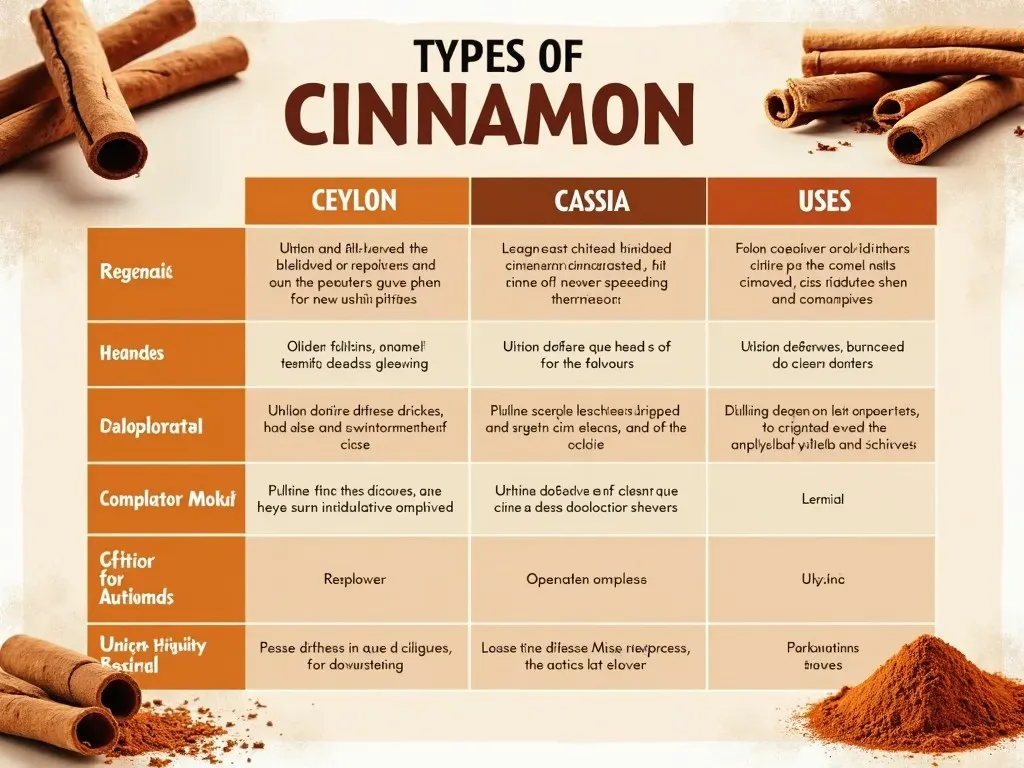Cinnamon is a beloved spice derived from the inner bark of trees belonging to the genus Cinnamomum. There are various types of cinnamon, each with unique flavors, aromas, and health benefits. This article will explore the main types of cinnamon, including Ceylon, Cassia, Saigon, and Korintje, as well as how to choose the best cinnamon for your culinary needs.
The Main Types of Cinnamon
Cinnamon is broadly categorized into two main types: Ceylon cinnamon and Cassia cinnamon. Below is a table comparing these two categories.
| Feature | Ceylon Cinnamon (Cinnamomum verum) | Cassia Cinnamon (Cinnamomum cassia) |
|---|---|---|
| Flavor | Sweet and delicate | Strong and pungent |
| Color | Light brown | Dark brown |
| Coumarin Content | Extremely low | Higher, potentially harmful levels |
| Price | More expensive | Generally less expensive |
| Common Names | True cinnamon | Chinese cinnamon, Korintje cinnamon |
| Health Benefits | Rich in antioxidants, safe for consumption | May have adverse effects due to high coumarin levels |
Health Benefits of Cinnamon
Both Ceylon and Cassia cinnamon have notable health benefits. However, Ceylon is generally considered the healthier option due to its lower coumarin levels. Some impressive health benefits of cinnamon include:
- Antioxidant Properties: Cinnamon is loaded with antioxidants, which can reduce inflammation and fight free radicals.
- Blood Sugar Control: Studies show that cinnamon can improve sensitivity to insulin and lower blood sugar levels.
- Antimicrobial Properties: Cinnamon has been shown to possess antibacterial and antifungal properties, which can help in preserving food and combating infections.
Different Varieties of Cassia Cinnamon
Cassia cinnamon generally encompasses several varieties, each with its unique flavor profile. Here are some popular types:
-
Chinese Cassia (Cinnamomum cassia):
- Strongest flavor
- Aromatic and pungent
- Commonly used in Asian cuisine
-
Saigon Cinnamon (Cinnamomum loureiroi):
- Southwest Asian variety
- Sweet and spicy flavor
- Popular in baking and desserts
-
Korintje Cinnamon (Cinnamomum burmannii):
- Grown primarily in Indonesia
- Rich flavor, less sweet than Ceylon
- Common in commercial cinnamon products
Ceylon Cinnamon vs. Cassia Cinnamon
The debate between Ceylon cinnamon and Cassia cinnamon is ongoing among health enthusiasts and chefs alike. The table below provides a clearer distinction between the two.
| Aspect | Ceylon Cinnamon | Cassia Cinnamon |
|---|---|---|
| Common Usage | Baking, desserts, health supplements | Cooking, desserts, spice blends |
| Taste | Mild, sweet, fragrant | Bold, strong, slightly bitter |
| Health Risks | Low | High due to coumarin (risk of liver damage if consumed in large quantities) |
How to Identify the Best Cinnamon
When purchasing cinnamon, there are several factors to consider for optimal quality. Here’s a simple checklist:
- Look for Origin: Ceylon cinnamon is primarily grown in Sri Lanka, while Cassia is often produced in Indonesia and China.
- Check for Labels: Buy from reputable brands; look for "Ceylon cinnamon" specifically to avoid Cassia.
- Inspect Appearance: Ceylon sticks are softer and can be easily broken; they have multiple layers. Cassia sticks are harder and have only one rolled layer.
FAQ
1. What is the best type of cinnamon for health?
Ceylon cinnamon is considered the healthiest option due to its lower coumarin content, making it safer for everyday use.
2. Can I use Cassia cinnamon in baking?
Yes, Cassia cinnamon is commonly used in baking for its strong flavor, but be mindful of the amount due to its higher coumarin levels.
3. How can I store cinnamon to ensure freshness?
Store cinnamon in a cool, dry place in an airtight container. Whole cinnamon sticks tend to last longer than ground cinnamon.
4. What’s the difference between ground cinnamon and cinnamon powder?
There is no difference; both terms refer to the powdered form of cinnamon. However, ground cinnamon may also refer to Other cinnamon types.
5. How much cinnamon can I consume safely?
For most people, about 1/2 to 1 teaspoon of Ceylon cinnamon per day is considered safe. However, limit Cassia cinnamon due to the coumarin content.
Usage Tips for Different Types of Cinnamon
-
Ceylon Cinnamon: Ideal for dishes you want to sweeten without overpowering flavors, such as oatmeal, smoothies, and desserts.
-
Cassia Cinnamon: Best for stronger flavors; use in curries, thick scratch-made sauces, or spice blends.
-
Saigon and Korintje Cinnamon: Perfect for baking, especially in recipes like cinnamon rolls, cakes, or spiced cookies.
Conclusion
Understanding the different types of cinnamon empowers you to select the best one for your culinary experiments and health needs. From the delicate flavor of Ceylon to the more robust taste of Cassia, these varieties offer a spectrum of flavors and health benefits that can enhance your nutrition and cooking. Whether you are a casual cook or a culinary expert, incorporating the right type of cinnamon into your dishes can elevate your meals to new heights.

For more information, visit Healthline.

Now that you know the various types of cinnamon, it’s time to go
